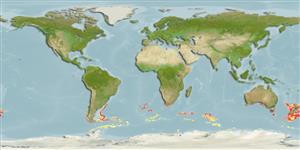>
Zeiformes (Dories) >
Oreosomatidae (Oreos) > Pseudocyttinae
Etymology: Pseudocyttus: Greek, pseudes = false + Greek, kyttaros, kytos = a convex cavity.
Environment: milieu / climate zone / depth range / distribution range
Sinh thái học
Biển Tầng đáy biển sâu; Ở đại duơng, biển (Ref. 51243); Mức độ sâu 400 - 1500 m (Ref. 5194), usually 900 - 1100 m (Ref. 36731). Deep-water; 34°S - 67°S, 90°W - 176°W (Ref. 27159)
Southwest Atlantic: off Uruguay to Argentina and the Falklands. Southeast Atlantic: Namibia to South Africa, including the northern part of Walvis Ridge (Ref. 6545). South Pacific: off southern Chile, Bellingshausen and Australian-Antarctic Basin to New Zealand, New South Wales and Tasmania, Australia and the Kerguelen Islands.
Length at first maturity / Bộ gần gũi / Khối lượng (Trọng lượng) / Age
Maturity: Lm 40.0 range ? - 41 cm
Max length : 68.0 cm TL con đực/không giới tính; (Ref. 58312); common length : 40.0 cm TL con đực/không giới tính; (Ref. 9258); Khối lượng cực đại được công bố: 5.0 kg (Ref. 6390); Tuổi cực đại được báo cáo: 100 các năm (Ref. 27140)
Các tia vây lưng cứng (tổng cộng) : 5 - 7; Các vây lưng mềm (tổng cộng) : 33 - 36; Tia cứng vây hậu môn: 2 - 3; Tia mềm vây hậu môn: 31 - 34; Động vật có xương sống: 40 - 43. First dorsal spine longer than second dorsal spine. Opercles fully scaled (Ref. 27159).
Female adult chocolate brown in color with darker fins; prejuveniles silvery with numerous dark spots of various sizes which become larger with age (Ref. 6548).
Inhabit continental slopes of all southern continents (Ref. 6545). Adults found near the bottom; juveniles near the surface, usually in association with krill (Ref. 5194). Feed mainly on salps (Ref. 27150). Eggs float near the sea surface and larvae also inhabit surface waters (Ref. 6390). There is no vertical migration during the day or night (Ref. 27150).
Displays seasonally synchronised reproduction (Ref. 6390).
Heemstra, P.C., 1990. Oreosomatidae. p. 226-228. In O. Gon and P.C. Heemstra (eds.) Fishes of the Southern Ocean. J.L.B. Smith Institute of Ichthyology, Grahamstown, South Africa. (Ref. 5194)
IUCN Red List Status (Ref. 130435: Version 2024-2)
Threat to humans
Harmless
Human uses
Các nghề cá: Tính thương mại
Các công cụ
Special reports
Download XML
Các nguồn internet
Estimates based on models
Preferred temperature (Ref.
123201): 2.1 - 6.1, mean 4.2 °C (based on 189 cells).
Phylogenetic diversity index (Ref.
82804): PD
50 = 1.0010 [Uniqueness, from 0.5 = low to 2.0 = high].
Bayesian length-weight: a=0.01995 (0.00813 - 0.04898), b=2.99 (2.77 - 3.21), in cm total length, based on LWR estimates for this (Sub)family-body shape (Ref.
93245).
Mức dinh dưỡng (Ref.
69278): 3.6 ±0.47 se; based on food items.
Thích nghi nhanh (Ref.
120179): Rất thấp, thời gian nhân đôi của chủng quần tối thiểu là hơn 14 năm (K=0.07; tmax=100; tm=31; Fec=6,000).
Fishing Vulnerability (Ref.
59153): High to very high vulnerability (72 of 100).
Climate Vulnerability (Ref.
125649): Moderate vulnerability (39 of 100).
Nutrients (Ref.
124155): Calcium = 16.2 [8.5, 36.6] mg/100g; Iron = 0.416 [0.153, 0.905] mg/100g; Protein = 17.2 [14.6, 20.0] %; Omega3 = 0.332 [0.167, 0.702] g/100g; Selenium = 24.3 [9.3, 71.5] μg/100g; VitaminA = 11.1 [1.8, 67.9] μg/100g; Zinc = 0.335 [0.207, 0.526] mg/100g (wet weight);
